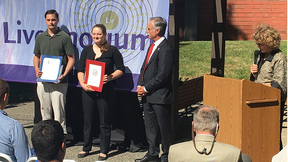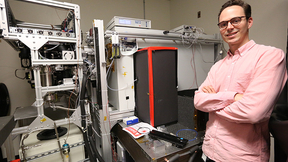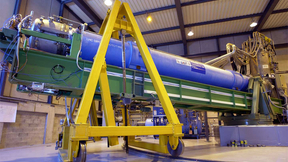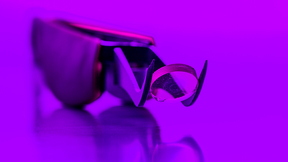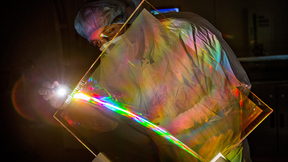Back
Lawrence Livermore National Laboratory physicist Félicie Albert received the 2017 Katherine E. Weimer Award by the American Physical Society, Division of Plasma Physics (DPP). The award will be presented during the DPP annual meeting the week of Oct. 23-27 in Wisconsin. Albert was awarded "For pioneering development and characterization of X-ray sources from laser…
Along with its aesthetic function of helping create the glorious Aurora Borealis, or Northern Lights, the powerful magnetic field surrounding our planet has a fairly important practical value as well: It makes life possible. By deflecting harmful charged particles from the sun and the cosmic rays that constantly bombard the planet, and preventing the solar wind from…
An international group of scientists has found that Jupiter is the oldest planet in our solar system. By looking at tungsten and molybdenum isotopes on iron meteorites, the team, made up of scientists from Lawrence Livermore National Laboratory and Institut für Planetologie at the University of Münster in Germany, found that meteorites are made up from two genetically…
Lawrence Livermore National Laboratory (LLNL) and collaborators are looking for a way to take carbon out of the air and make money doing it. The Center for Carbon Removal, in partnership with Lawrence Livermore and several academic and research institutions, launched a new industrial innovation initiative this week with the goal of developing solutions that transform waste…
Yongqin Jiao is the principal investigator of MicroMiners, a project focused on rare-earth bioadsorption, or using genetically engineered bacteria to recover rare-earth elements from sources where levels are so low that recovery by ordinary means would be prohibitively expensive.
Lawrence Livermore National Laboratory (LLNL) handed out the 2017 Edward Teller science scholarship awards to two Livermore high school students last week as the city celebrated the fifth anniversary of Livermorium Day, recognizing the Lab’s contribution to the discovery of superheavy element 116. Local dignitaries, Lab employees and community members gathered for the…
A technology originally developed to smooth out and pattern high-powered laser beams for the National Ignition Facility (NIF) can be used to 3D print metal objects faster than ever before, according to a new study by Lawrence Livermore researchers. A team of Lab scientists report the findings in the latest issue of Optics Express, published online on May 15. This new…
Lawrence Livermore National Laboratory (LLNL) researchers have developed a laser-based tabletop device to measure carbon-14 (radiocarbon). In biological systems, carbon-14 (14C ) can be used as a biochemical tracer to track micro-doses of nutrients, toxins and therapeutics in humans and animals. For example, the 14C can be tacked on to a vitamin. When a human ingests the…
Prescription drugs have enabled millions of Americans with chronic medical conditions to live longer and more fulfilling lives, but many promising new drugs never make it to the human trials stage due to the potential for cardiac toxicity. Through "heart-on-a-chip" technology — modeling a human heart on an engineered chip and measuring the effects of compound exposure on…
Lawrence Livermore National Laboratory (LLNL) researchers, as part of a Navistar SuperTruck I team, helped design a new type of tractor-trailer truck that significantly improves fuel economy. The new SuperTruck vehicle achieved 13 mpg on public roads and a 104 percent freight efficiency improvement. Forty-eight percent of this improvement comes from aerodynamic…
Lawrence Livermore National Laboratory (LLNL) researchers, along with international collaborators, are on a mission to find particles contributing to dark matter, which is expected to make up most of the matter in the universe. In a paper published May 2 in Nature Physics, the CERN Axion Solar Telescope (CAST) at CERN presented new results on the properties of axions --…
Lawrence Livermore National Laboratory scientists and academic collaborators have demonstrated the synthesis of transparent glass through 3D printing, a development that could ultimately lead to altering the design and structure of lasers and other devices that incorporate optics. A team of LLNL researchers, along with scientists from the University of Minnesota and…
A novel way to harness lasers and plasmas may give researchers new ways to explore outer space and to examine bugs, tumors and bones back on planet Earth. Lawrence Livermore National Laboratory (LLNL) physicist Félicie Albert led an international team pursuing this new regime in laser research, which was described in a Physical Review Letters (PRL) paper published online…
Like a chameleon changing colors to blend into the environment, Lawrence Livermore researchers have created a technique to change the color of assembled nanoparticles with an electrical stimulant. The team used core/shell nanoparticles to improve color contrast and expand color schemes by using a combination of pigmentary color (from inherent properties) and structural…
Silky chocolate, a more effective medical drug or solar panels all require the same thing: just the right crystals to make the material. Now scientists trying to understand the paths crystals take as they form have been able to influence that path by modifying the starting ingredient. The insights could lead to better control of drug development, energy technologies and…
An international team of scientists, including one from Lawrence Livermore National Laboratory (LLNL), has found that up to 20 percent loss in the annual maximum amount of water contained in the Western United States’ mountain snowpack in the last three decades is due to human influence. Peak runoff in streams and rivers of the Western U.S. is strongly influenced by…
Materials scientists at Lawrence Livermore National Laboratory (LLNL) got a step closer to understanding defect interaction dynamics in silicon carbide. When an energetic particle, such as a neutron or an ion, impinges onto a material, the particle penetrates and creates displacements by ballistic processes of knocking off lattice atoms from their equilibrium positions…
Americans used more renewable energy in 2016 compared to the previous year, according to the most recent energy flow charts released by Lawrence Livermore National Laboratory. Overall, energy consumption was nearly flat. Each year, the Laboratory releases energy flow charts that illustrate the nation's consumption and use of energy. Americans used 0.1 quads (quadrillion…
A new anti-reflective coating and a novel chemical process for laser optics, developed by Lawrence Livermore National Laboratory (LLNL) researchers, represents an important breakthrough in its effort to boost the energy of the National Ignition Facility’s (NIF) 192 giant lasers, and cut the cost of repairing or replacing damaged optics vital to its operation. The coating…
Lawrence Livermore National Laboratory (LLNL) researchers have adapted theoretical models to predict the failure behavior of miniaturized 3D lattice structures and have used advanced characterization techniques to demonstrate that these failures exist. Specifically, experiments showed a transition in failure modes for stretch-dominated lattice structures at low relative…






